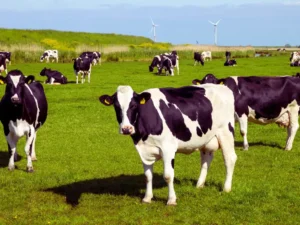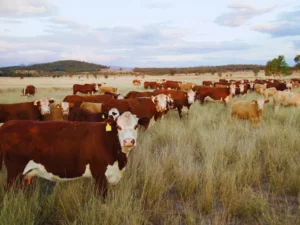Summary
E-Livestock Global, in collaboration with MasterCard, is offering a blockchain platform that leverages UHF RFID technology to track cattle health, vaccinations, and disease treatments. This innovative system is being deployed in Zimbabwe, helping farmers, veterinarians, and beef buyers ensure the health and traceability of cattle. By recording and sharing data on each animal, this solution is set to transform cattle management across Africa and beyond. The technology provides long-range RFID tracking, reduces theft risks, and supports sustainable livestock practices.
The Role of Blockchain and RFID in Cattle Health Management
The Need for Traceability in Livestock
Traceability in the livestock industry is crucial for monitoring cattle health, managing disease outbreaks, and ensuring animal welfare. In Zimbabwe, where a 2018 tick-borne disease outbreak devastated the cattle industry, traceability has become even more essential. E-Livestock Global’s blockchain-based solution integrates UHF RFID tags to digitally track cattle, providing farmers with vital health and transaction data. This approach helps farmers prove the health of their cattle while improving overall herd management.
Benefits of UHF RFID Tags in Cattle Tracking
UHF RFID tags offer significant advantages over traditional LF or HF tags:
- Longer Read Range: UHF RFID tags can be read from distances of up to 20 meters, making it easier for farmers to monitor large herds without needing to manually scan each tag.
- Accurate Data Collection: Each RFID tag is linked to a blockchain database, ensuring secure and immutable records of the animal’s health history, including vaccinations, anti-tick treatments, and disease events.
- Cost Efficiency: The tags are available at a low cost of $2 per cow, providing small and large farmers with an affordable way to digitize livestock management.
The Blockchain Platform for Cattle Health

Capturing and Storing Data on the Blockchain
Each cow in the system carries a UHF RFID tag that stores key information in a blockchain. When a reader scans the tag, it records the cow’s unique ID and health data on the blockchain. This system ensures transparency and provides stakeholders with access to an immutable health record, reducing the risk of disease spread and improving cattle management practices.
Supporting Livestock Health and Reducing Rustling
In Zimbabwe, the system tagged 10,000 cattle to reduce rustling and eliminate the need for branding. By storing data on the blockchain, it tracks each cow’s movements and treatments, thus allowing buyers to verify the animal’s health before purchasing. Additionally, this added layer of transparency helps build trust in the quality of Zimbabwean beef, both in local and international markets.
Key Technologies Supporting E-Livestock Global’s Solution
UHF RFID Tags and Blockchain Integration
The UHF RFID tags, developed by Avery Dennison, include a QR code and numeric ID that link to each cow’s health and ownership records. Handheld CS108 readers from Convergence Systems Ltd. (CSL) read these tags and are designed for rugged environments like cattle farms. The reader initiates the blockchain history for each animal, storing all subsequent data in the cloud for easy access by farmers, veterinarians, and other stakeholders.
Multispecies Application and Expansion Plans
While the technology currently serves cattle, the company plans to extend it to other livestock, such as sheep, pigs, and goats. The Zimbabwe Parks and Wildlife Management Authority has also expressed interest in using RFID tags for tracking wildlife like elephants, providing a lower-cost alternative to satellite tracking.
Frequently Asked Questions

- What is the primary benefit of using UHF RFID tags in cattle management?
UHF RFID tags allow for long-range reading, reducing the need for manual scanning. This system provides accurate data on cattle health and movements, helping to prevent disease and ensure transparency in livestock management.
- How does blockchain enhance cattle health monitoring?
Blockchain stores each cow’s health and treatment records in an immutable, transparent system. Farmers, veterinarians, and buyers can access this data securely, providing a trusted source of information regarding each animal’s health history.
- What challenges does this technology address?
This system addresses key challenges such as reducing cattle rustling, improving disease control, and ensuring traceability from birth to sale. It also helps manage collateralization by recording whether a lien exists on a cow.
- How does the system work in areas with poor network connectivity?
Readers can store data locally and upload it to the blockchain once they are back in range of a network, ensuring continuous functionality even in remote areas.
- Is this technology applicable to other animals?
Yes, the system works for other livestock, such as sheep, pigs, and goats. The company is also exploring its use for tracking wildlife, including elephants.
Comparison of UHF RFID and Traditional LF RFID in Cattle Health Monitoring
| Feature | UHF RFID | LF RFID |
| Read Range | Up to 20 meters | Short range (manual scanning required) |
| Data Storage | Blockchain-integrated, immutable records | Local or database storage is less secure |
| Use in Harsh Conditions | Rugged tags, suitable for farm environments | Less durable in extreme conditions |
| Cost | Low cost ($2 per cow) | Higher cost with less functionality |
| Compatibility | Multispecies (cattle, sheep, pigs) | Primarily for cattle |
This table highlights the superiority of UHF RFID in modern cattle health management, providing a comprehensive, long-range, and cost-effective solution over traditional LF RFID systems.
